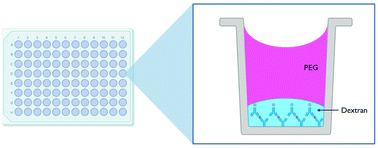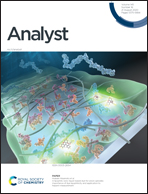Aqueous two-phase system antibody confinement enables cost-effective analysis of protein analytes by sandwich enzyme-linked immunosorbent assay with minimal optical crosstalk†
Abstract
An aqueous two-phase system formed from polyethylene glycol and dextran was used to uniformly coat the bottom surfaces of the wells of standard 96-well assay plates with capture and detection antibodies to improve the performance and cost-effectiveness of sandwich enzyme-linked immunosorbent assay (ELISA). Using this approach, limits of detection and linear dynamic range values comparable to those obtained for conventional sandwich ELISA were obtained using considerably lower antibody quantities due to the much lower reagent volumes required when antibodies are applied in a dextran solution beneath a polyethylene glycol overlay. Confinement of the antibody reagents to the bottom surfaces of the wells within the dextran phase also dramatically decreased the optical crosstalk present between neighboring wells when using transparent microplates. Adaptation of the conventional single sandwich ELISA for aqueous two-phase system antibody confinement was demonstrated by analysis of standard curves for C-reactive protein, transforming growth factor beta 1, and the chemokine CXCL10.



 Please wait while we load your content...
Please wait while we load your content...